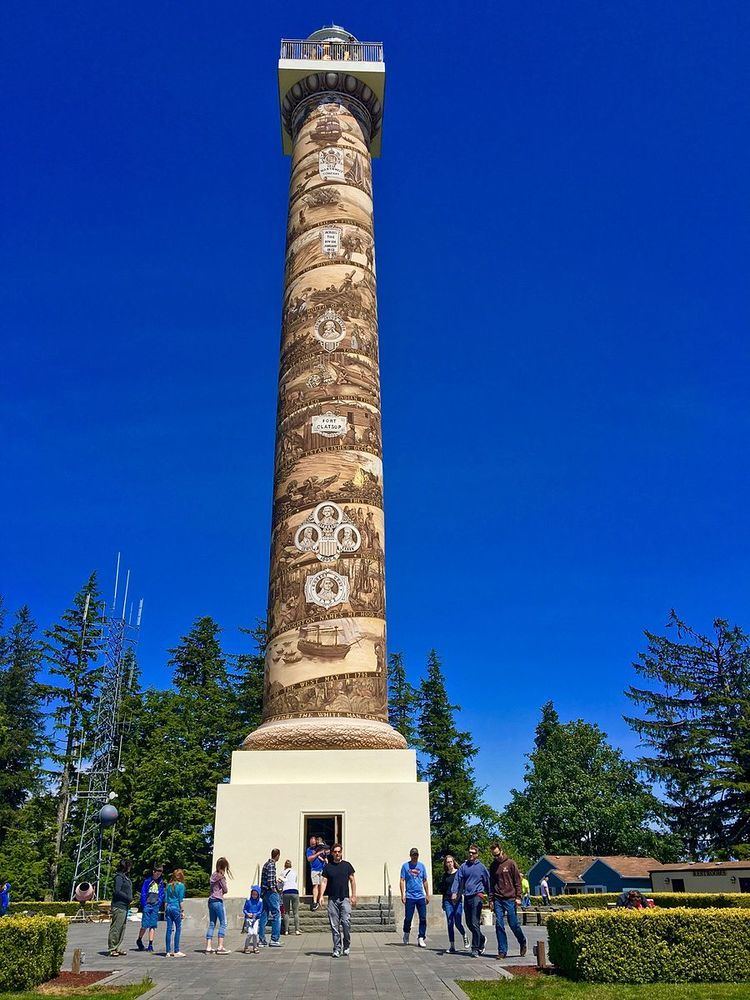NRHP Reference # 74001681 Phone +1 503-325-2963 | Built 1926, 91 years ago Area 8,094 m² Added to NRHP 2 May 1974 | |
 | ||
Address 1 Coxcomb Dr, Astoria, OR 97103, USA Hours Open today · 9AM–5PMMonday9AM–5PMTuesday9AM–5PMWednesday9AM–5PMThursday9AM–5PMFriday9AM–5PMSaturday9AM–5PMSunday9AM–5PM Similar Columbia River Maritime, Astoria–Megler Bridge, Captain George Flavel Ho, Fort Clatsop, Fort Stevens Profiles | ||
Astoria column
The Astoria Column is a tower in the northwest United States, overlooking the mouth of the Columbia River on Coxcomb Hill in Astoria, Oregon. Built 91 years ago in 1926, the concrete and steel structure is part of a 30-acre (12 ha) city park. The 125-foot (38 m)-tall column has a 164-step spiral staircase ascending to an observation deck at the top and was added to the National Register of Historic Places on May 2, 1974.
Contents
Oregon coast episode 3 shipwreck goonies astoria column
History
The tower was built in 1926 with financing by the Great Northern Railway and Vincent Astor, the great-grandson of John Jacob Astor, in commemoration of the city's role in the family's business history. Patterned after the Trajan Column in Rome (and Place Vendôme Column in Paris), the Astoria Column was dedicated on July 22, 1926. In 1974, the column was listed in the National Register of Historic Places. The murals that make up the column were refurbished in 1995 and a granite plaza was added in 2004.
The Astoria Column was one of a series of monuments erected by Great Northern Railway in 1925 and 1926.
Details
The 125-foot (38 m)-tall column stands atop 600-foot (180 m)-tall Coxcomb Hill and includes an interior spiral staircase that leads to an observation deck at the top. The spiral sgraffito frieze on the exterior of the structure is almost seven feet wide, and 525 feet (160 m) long. Painted by Electus D. Litchfield and Attilio Pusterla, the mural shows 14 significant events in the early history of Oregon with a focus on Astoria's role including Captain Gray's discovery of the Columbia River in 1792 and the Lewis & Clark Expedition.
Designed to resemble the Roman Trajan's Column, the Astoria Column was built of concrete and has a 12-foot (3.7 m) deep foundation. Built at a cost of $27,133.96 ($362,840.21 in 2014 dollars), the tower has 164 steps to the top, where there is a replica of the State Seal of Oregon.
A plaque near the column commemorates the pioneering Community Antenna Television (CATV) system built by local resident Leroy E. "Ed" Parsons, initially at the Hotel Astoria, in which twin-lead transmission wires redistributed the signal of KRSC-TV (now KING-TV) in Seattle, Washington to area homes. Former Astoria resident Byron Roman was also involved in early cable invention and distribution.
The cast-iron spiral staircase inside the column was closed for safety reasons in November 2007. It was reopened to the public in time for the Regatta in August 2009.
